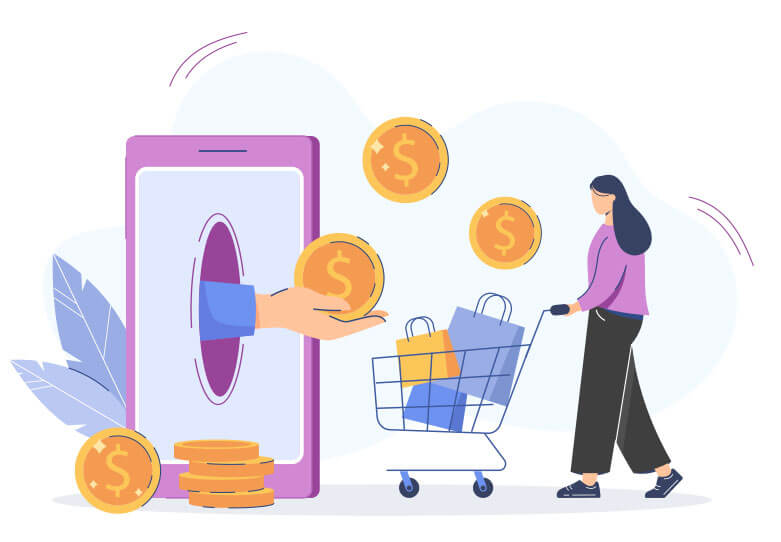Banking on loyalty programs to boost customer retention
The global Banking, Financial Services and Insurance (BFSI) sector is standing at the threshold of a transformation. With digital boundaries being broken by players like FinTech, financial organizations are waking up to the power of an online presence. The writing is on the wall: digitalization is no longer a nice-to-have, but a must-have.
Customers are also becoming more quality conscious. If their demand for personalized, relevant services are not met, they will switch ships, and move to competitors who offer the customer services and incentives that they’re looking for. Surveys have shown that 75% of consumers believe they would switch brands if they were offered a better, tailor-made loyalty program.

Technology-driven loyalty solutions are emerging as a trusted way to strengthen the bond between financial enterprises and their audience. It’s fast becoming the next-gen customer retention tool that builds trust, ensures customers stay loyal to a brand, and boosts digitization. Reward programs also improve customer experiences and help businesses meet the heightened expectations of tech savvy users, and create new revenue streams.
In this blog, we will get a 360-degree view of how loyalty solutions impact the BFSI industry – spanning the sector’s customer
retention challenges, and how reward programs can help overcome these retention roadblocks.
Customer retention challenges of the BFSI sector
Financial organizations that have retained old-school business models and refrained from walking down the digitization road are finding it increasingly difficult to retain customers. As per a Foresight Research by GlobeNewswire, in 2020, about 44 million people considered leaving their old banks and moving to financial organizations that offer personalized rewards and customer services. This left banks with little choice but to focus on customer retention and create next-generation loyalty programs.

What are the major customer retention challenges faced by the banking sector?
-
Lack of personalized rewards and experiences
A Capgemini study found that 77% of transaction-based programs failed in the first two years. The primary reason for this is a lack of personalization. In fact, surveys have found that only about 10% of loyalty programs provide personalized rewards that are based on a customer’s purchase history or other personal preferences and parameters. In today’s increasingly competitive banking ecosystem, a missing focus on personalization can increase churn rate.
A 2021 report by Next in Personalize found that offering tailor-made reward programs can drive up revenue growth by 15% for financial organizations. What’s more modern customers are willing to share personal data, like their lifestyle and location information, in order to receive personalized incentives from their banking partners.
-
Modern customers are spoilt for choice
New-age banking customers love their rewards, discounts, and coupons. Studies have found that over 80% of modern banking users expect incentives either in the form of bank loyalty programs or sign-up bonuses. Also, the quality of the relationship that consumers have with their banks plays a huge role in determining whether they stay, or look elsewhere to satisfy their financial needs. As competition stiffens in the financial sector, it has become easier for customers to switch to a competitor that offers more personalized and attractive deals. This has made it imperative for financial businesses to onboard customer retention tools like loyalty programs.
-
Loyalty programs that lack relevance don’t make the cut with customers
Users are not interested in loyalty programs that don’t add value to their lives. The financial services sector is increasingly realizing that loyalty should be about emotional engagement. This can be achieved by offering next-gen programs and creating new touchpoints that engage with customers outside of the transaction cycle. Companies that roll out these incentives show that they care about their customers.
Loyalty programs can boost customer retention. How?
Studies have shown that an average consumer is a user of about five different financial services providers. The diversity of digital banking options means customers can easily work with several banking brands at the same time.
How do financial customers choose the best providers to partner with? Rewards, personalized deals, incentives, and the pricing of financial products are the biggest drivers behind this decision-making process. Studies have found that about 75% of consumers are more likely to recommend a brand with a robust reward program.
It is no wonder that financial institutions are increasingly offering tailor-made loyalty solutions, along with positive experiences and seamless services.
Must-have features for a successful BFSI loyalty program
It’s a well-known fact that selling to repeat customers costs a lot less than acquiring new customers. That’s one of the primary reasons why brands invest in loyalty and rewards programs.
Loyalty programs have consistently proven to be one of the most sure-shot tactics for increasing revenue and inspiring customer loyalty. About 84% of consumers say they prefer to stick with a brand that offers a loyalty program. That’s not all: 66% of consumers say that earning rewards actually changes their spending behavior.
Loyalty programs have been around for long. Successful customer loyalty programs in different industries have several common characteristics, like simplicity, flexibility, personalization, and profitability.
A customer loyalty program must be relevant to customers as well as financially viable for the company. What are the features that make a loyalty program a success in the banking sector? Here’s a list of must-haves:

-
Attractive sign-up incentives
Your loyalty program must be attractive and beneficial to your customers in order to get them to sign up. A good example of this would be an experiential reward at the time of signing up. Timelines are also important. Ensure that your customers receive their first reward soon after they sign up, and the next in a pre-stipulated time frame. Also, monetary rewards should not be the be-all and end-all of a loyalty solution. Adding components like event invitations, special services, and gamification increases customer involvement and sparks brand interest.
-
KPIs to measure profitability for businesses
A customer loyalty program must be profitable and deliver a return on investment for the financial enterprise. This can be achieved if the solution drives cross-selling and upselling, and includes targeted incentives that nudge users to buy complementary products. Financial institutions must have a designated set of KPIs to measure the success of their loyalty solution. These would include changes in the customer retention rate, customer lifetime value, or net promoter score.
-
Provide customers with the flexibility of multiple choices
A reward program is deemed a success when it provides customers with the flexibility to choose how they want to earn or redeem points. For instance, a user can earn or spend points with different partners or pick from a spectrum of channels. Customers can also be allowed to pick from a diverse option of activities through which they can accumulate points. This could span trying new offers, subscribing to newsletters, or via a recommendation.
-
Personalize to perfection
One of the most effective ways to woo your customer is to roll out individualized reward offers. This ensures that every user receives tailor-made suggestions that are relevant and preferred by them. Personalization also gives financial institutions the option to offer the best benefits to their high-value and high-potential customers. With incisive customer data now at the fingertips of most businesses, personalization has become easier to achieve.
-
Keep your loyalty solution simple
Customers should not be made to feel like they’re enrolling into an over-complicated system when they go through the details of a financial reward program. It’s critical to keep it simple – and this can be achieved by using illustrations, tables, and symbols to explain how the program works. After all, the objective of any customer-centric solution is to remove barriers to entry and guide customers along a well-defined road. Internally, the program can have layers and complex algorithms and mechanisms. But this should not be transferred to the customer.
Best practices to make loyalty programs impactful in digital banking
Here are some tips on how to turn loyalty programs into a profitable solution that helps financial organizations improve customer experience and increase retention:
01 Onboard a banking CRM system
The most significant benefit that CRM systems bring to an organization is efficient customer segmentation. It also keeps the entire customer database in one place and helps marketers collate and manage customer information. This empowers banks to run personalized and savvy reward programs. With a banking CRM solution in place, enterprises can make precise target audience segmentation that is based on the income, demographical data and purchase patterns of customers.
02 Get a unified view of loyalty programs
A single-window view of loyalty programs across channels helps organizations measure outcomes and processes more efficiently. It becomes easier to track different metrics, use the right KPIs to gauge their performance, and also track customer involvement across channels. A unified program view enables customers to track their reward points on various devices.
03 Gamify
Gamification is a great way to increase customer engagement and loyalty. When elements of gamification are used in customer loyalty programs, they inevitably boost popularity, draw a larger audience, and boost engagement between a brand and a user.
04 Get creative with customer onboarding
A creative and out-of-the-box onboarding process is a great way of letting customers know their interest is on top of the charts for their banking partner. How can a bank make its onboarding stand out from the crowd? Here are some ways to do it: create intuitive navigation, develop a mobile or web experience that resolves all customer issues online, power up the identity verification system, use autofill to avoid answering the same questions repeatedly, and make account and product access a speedy process.
Easyrewardz BFSI loyalty program: Game-changer for the banking sector
Financial institutions are realizing that loyalty programs are not just a tool to attract new customers. They’re also a building block to nurture long-term customer relationships. After all, modern banking is built on personal and emotional relationship between a bank and its customers.
Easyrewardz end-to-end banking loyalty and reward management solutions help financial organizations engage better and build stronger customer bonds. Powered by LPaaS Banking, enterprises can set up rule-based loyalty programs that boost customer retention through highly targeted, relevant, and personalized offers.
Adding to the solution’s USP are advanced analytics, a high-frequency dashboard, and real-time transactional reporting that help businesses identify customer behavior patterns and reward them with points or coupons – based on their purchase frequency and history.
The solution’s 360-degree rewards program can be managed and tracked from an online rewards catalog on the Easyrewardz self-service portal. Customers can earn rewards in real-time, through points, vouchers, or cashbacks.

The tangible and intangible benefits that the Easyrewardz BFSI loyalty solution brings to the table include:
Reward customers for their value and the width of relationship.
Create cross-sell, and upsell opportunities for the bank based on targeted segments.
Recognize and motivate customers to increase customer value.
Create advocacy and acquisition opportunities.
Achieve a ‘one customer’ view across products.
Sum up: Onboard loyalty solutions to stay relevant with your customer base
Besides driving multiple KPIs, bank loyalty programs boost customer retention and improve user engagement. With the right technology solutions, this multifunctional tool can enable financial institutions to stand out from the competition. Banking businesses that seamlessly connect account holders to rewards, discounts, and coupons, are more effective in staying relevant with their customers and boosting their bottom lines.
